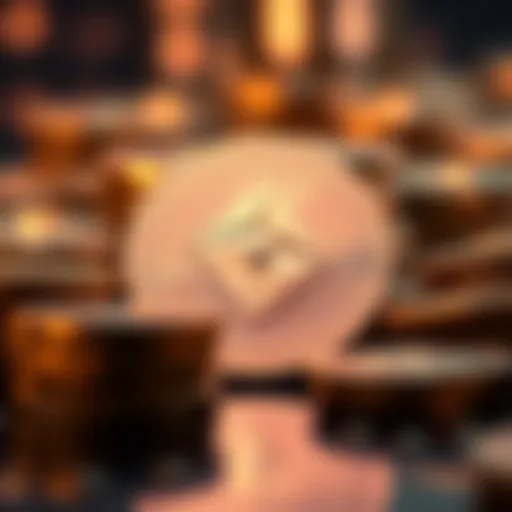The Fusion of NFT Art and Sculpture in Today’s Market


Intro
The world of art is undergoing profound changes, especially at the intersection where traditional forms meet emerging digital realms. It's not just about paint on canvas anymore; with the advent of NFT art, we are seeing a transformation that profoundly influences mediums like sculpture. In this exploration, we take a closer look at how NFTs are reshaping the landscape of sculptural art, providing creatives and collectors alike with unprecedented opportunities.
This journey will cover a variety of aspects, ranging from how the principles of NFTs connect with the age-old tradition of sculpture to the implications of these interactions in contemporary art markets. We aim to break apart the intricate layers that make up this dynamic relationship, highlighting both challenges and advantages as we navigate through this brave new world.
Market Insights
In recent years, the art and cryptocurrency markets have become increasingly intertwined. As NFT art gains traction, understanding the current market trends is essential for those who are contemplating investments in this domain.
Current Trends in Cryptocurrency Markets
The NFT marketplace has experienced exponential growth, particularly in the past few years. People are not just buying pieces digitally; they are investing in assets that might appreciate over time. This trend is mirrored in the broader cryptocurrency landscape as well.
- Increased Adoption: More individuals and institutions are recognizing the value of NFTs, leading to a diverse range of creators entering this space.
- Crossover with Traditional Art: We’re witnessing traditional galleries and auction houses experimenting with NFT exhibitions, blurring the lines between classical and digital art.
- Accessibility: Prices have started to democratize, with artists priced out of traditional markets now finding homes for their work in the NFT space.
Key Indicators for Market Analysis
Knowing where the market stands requires a keen understanding of the indicators that shape it. Here are some significant metrics to keep an eye on:
- Total Market Capitalization: This tells us how much money is flowing into the entire NFT ecosystem.
- Transaction Volume: Higher transaction volumes can signify growing interest and liquidity within the market.
- Unique Holders: The number of unique wallets holding NFTs gives insight into how widespread the adoption is.
"The landscape of arts has broadened. What once existed in galleries now dances in the realm of blockchain."
Blockchain Innovations
Let’s delve into the very backbone of NFTs—the blockchain. Its innovations are key to understanding how we’ve arrived at this intersection of technology and art.
Emerging Blockchain Technologies
With each passing day, new advancements in blockchain technology are unveiled, allowing for more intricate and fluid interactions between art and its digital representations. The use of Ethereum as the primary blockchain for many NFTs gives artists and collectors sophisticated tools to create, buy, and sell.
- Layer 2 Solutions: These are crucial for scaling transactions and reducing fees, making NFT art more accessible.
- Smart Contracts: Artists can code royalties into their work, ensuring they earn from future sales, a game-changer for many creators.
Real-world Applications of Blockchain
The ways blockchain can be applied in real-world scenarios related to art are endless. Consider:
- Provenance Tracking: Each piece has a verified history, which can help cut down on forgeries and misinformation.
- Fractional Ownership: Artists might offer pieces in fractions, allowing fans and collectors to own a piece without fronting the full price.
In summary, as NFT art works and sculptures converge, they aren’t merely intersecting; they're forging new paths for creativity that challenge traditional perceptions of ownership and value. In our subsequent exploration, we will dive deeper into the aesthetic considerations and cultural ramifications of this fusion.
Foreword to NFT Art
In today’s fast-paced digital landscape, the discussion surrounding NFT art has become not only relevant but also crucial for understanding the broader shifts in the art world. Non-fungible tokens, or NFTs, signify a fundamental change in how we perceive ownership, value, and authenticity in digital art. The rise of these digital assets invites artists, investors, and academics alike to reconsider the frameworks that govern artistic expression.
The significance of NFT art can’t be overstated. As digital creations gain platforms to be bought, sold, and displayed, the barriers that traditionally existed between artists and their audience dissolve. This democratization of art opens the floodgates for creators who might once have struggled for recognition in a crowded marketplace.
What can we glean from this phenomenon? A significant advantage of NFT art is its potential for artists to retain royalties on secondary sales through smart contracts. This offers a revenue model that contrasts sharply with the age-old system, where once an artwork is sold, it's all too often a one-way street for the initial creator.
In this exploration of NFT art, we will delve deep into its definitions and applications within the contemporary art scene. We will also investigate how this digital shift intersects with traditional art forms, particularly sculpture, thus laying the groundwork for a holistic understanding of art in the age of technology.
"NFTs are more than just digital art; they are a reimagination of ownership and creation within a new, sophisticated framework."
Keywords to consider for search optimization include NFT art, digital ownership, blockchain technology, and artist royalties. Each plays a vital role in connecting various aspects of this discussion.
What are NFTs?
Non-fungible tokens, or NFTs, are unique cryptographic tokens that exist on a blockchain and represent ownership of a specific item or piece of content. Unlike cryptocurrencies such as Bitcoin, which are interchangeable and can be traded on a one-to-one basis, NFTs are distinct, making each token irreplaceable. This uniqueness is what gives them intrinsic value and the potential for significant impact on various fields beyond art, including gaming, real estate, and intellectual property.
:Key characteristics of NFTs:
- Indivisibility: You cannot divide an NFT like a cryptocurrency. Each token stands alone.
- Authenticity: Blockchain technology ensures that the ownership and provenance of an NFT are verifiable, establishing its originality and scarcity.
- Interoperability: NFTs can be bought, sold, or traded across different platforms, ensuring flexibility in their use and distribution.
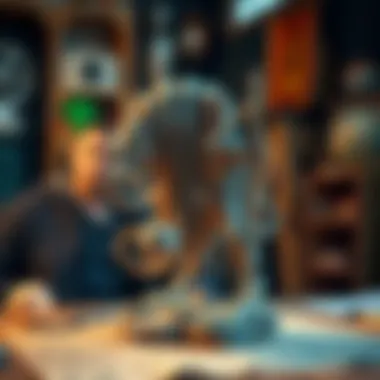
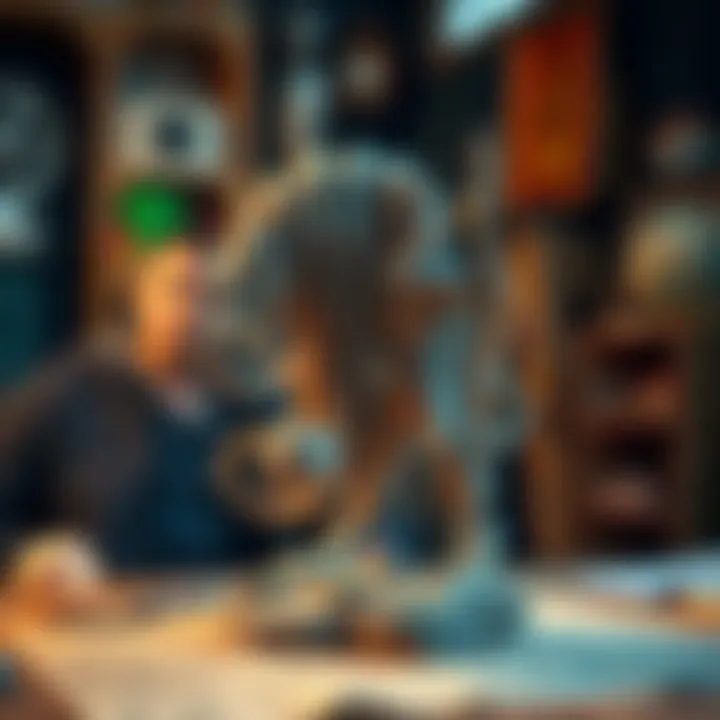
The Rise of Digital Art
The digital art movement has layered itself intricately over the last couple of decades, yet it was only with the advent of NFTs that it truly gained the spotlight. Artists have embraced digital mediums, creating stunning works that represent the digital age. As technology has evolved, so too has the capacity for creativity, with techniques such as digital painting, 3D modeling, and animation gaining widespread acknowledgment.
This rise of digital art wasn’t without its challenges. Traditionally, digital creations faced issues related to authenticity and ownership. Artists often struggled to find markets where they could sell their work meaningfully. With NFTs, a turning point was reached. They provided a solution that allowed creators to forge a stronger connection with their audience—ensuring that their original creations could be identified, owned, and traded in the marketplace.
Intersection with Traditional Art Forms
The intertwining of NFT art with traditional forms raises questions about authenticity, craftsmanship, and the evolution of art itself. Sculpture, which has enduring roots in human expression, finds itself at the crossroads of this modern digital revolution. Traditionally, sculptures require physical materials and artistic skill, but digital sculpting opens new avenues for artistic exploration.
In essence, what does it mean when a sculpture can be both a tangible object and a digital asset? This intersection raises critical discussions about:
- Value: How do we assess a digital sculpture’s worth in comparison to its physical counterpart?
- Existential Queries: Does the digital form detract from the artistry involved in creating the physical object?
- Hybrid Models: Can there exist a symbiotic relationship where both digital and physical forms enhance one another?
As we traverse this landscape, we’ll begin to establish a roadmap that not only recognizes the advancements within NFT art but also illustrates its implications for the future of sculpture and traditional art forms.
Understanding Sculpture in a Digital Era
The advent of digital technology has fundamentally altered the landscape of art, including the realm of sculpture. Understanding this transformation is crucial for appreciating how traditional artistic forms adapt and evolve in a contemporary context. In a world where physical objects coexist with digital constructs, the very definition of what sculpture can be is rapidly expanding. This section delves into the historical context, modern techniques, and the intricate relationship between physical and digital sculptures, illuminating the opportunities and challenges artists face today.
Historical Context of Sculpture
Sculpture has a rich history, tracing back to ancient civilizations where it was often used in religious and regal contexts. The Greeks and Romans paved the way with their mastery in marble and bronze, creating timeless works that conveyed power and beauty. However, in recent decades, the definition of sculpture has broadened significantly.
In the 20th century, movements like Abstract Expressionism and Minimalism shifted the focus from traditional materials to more experimental forms, including plastics and found objects. Today, we witness a further evolution where technology plays a starring role. Now, digital tools enable artists to design pieces without the constraints of physical media. The emergence of 3D printing, for instance, allows sculptors to create intricate designs that would be daunting or nearly impossible to craft by hand. This historical backdrop helps us see how the past feeds into the present, making today’s digital sculptures both a continuation and a departure from longstanding traditions.
Digital Sculpting Techniques
The methods used in digital sculpting have diversified, embracing both innovation and accessibility. Artists now wield software like Blender, ZBrush, and Autodesk Maya, transforming pixels into three-dimensional forms. These tools not only allow for precision but also enable real-time collaboration across geographies.
Benefits of digital sculpting techniques include:
- Flexibility: Artists can make rapid alterations, experimenting freely before committing to a final design.
- Collaboration: Cloud-based platforms allow multiple artists to work on a single piece from different locations.
- Integration: Digital files can be easily converted for 3D printing or virtual exhibitions, bridging the gap between the digital and physical.
These techniques democratize the art-making process, allowing a new wave of creators to engage in sculpture who might have felt daunted by traditional methods.
Bridging the Gap: Physical and Digital Sculptures
With the advent of NFTs, the gap between physical and digital sculptures has begun to close. Artists can now sell their digital works in unique, verifiable forms, gaining a foothold in the art market that was previously difficult to attain. However, this blending raises important questions about the value and ownership of art. Can a digital representation of a sculpture truly convey the same emotional heft as its tangible counterpart?
While some might argue that the tactile experience of a physical piece is irreplaceable, others point out the endless possibilities offered by digital formats, such as interactive elements or virtual reality settings.
Considerations Include:
- Authenticity: As digital art grows, establishing provenance and ownership becomes pivotal—this is where blockchain technology plays a significant role.
- Market Dynamics: Digital sculptures can reach global markets swiftly, which could reshape traditional pricing and valuation methods.
- Cultural Perception: The merging of physical and digital forms challenges our understanding of what constitutes "art" in contemporary society.
As we navigate these waters, it becomes evident that sculpture—both traditional and digital—is entering a new era marked by innovation and interconnectivity, reshaping how artists create, distribute, and engage with their work.
The Role of Blockchain in NFT Art and Sculpture
In the intertwining world of NFT art and sculpture, blockchain technology serves as the backbone, providing the necessary frameworks for authenticity, ownership, and economic viability. By leveraging this innovative technology, artists and collectors can navigate through uncharted waters, distinct from the traditional art markets. In this section, we will dissect the critical aspects of blockchain that elevate NFT art and sculpture to new heights.
Blockchain Basics for Artists
Before diving into the nitty-gritty of how blockchain influences the creative landscape, it’s crucial to grasp the basics of this technology. Blockchain operates as a decentralized ledger, securely recording digital transactions across a network of computers. Each transaction is grouped into blocks, which are then linked sequentially, forming a chain (hence the name).
- Transparency: Every transaction can be traced, ensuring both buyers and sellers can verify the authenticity of the artwork. This builds trust among participants in the market.
- Decentralization: Artists are not obligated to rely on intermediaries like galleries or auction houses, allowing for a direct connection to collectors.
- Immutability: Once a transaction is recorded, it cannot be altered. This is vital for artists who want to maintain the integrity of their work and ownership details.
For artists venturing into this space, understanding how to navigate blockchain technology is essential. Whether creating their own NFT or participating in online marketplaces, artists should familiarize themselves with platforms like OpenSea or Rarible to take full advantage of what blockchain has to offer.
Smart Contracts: Redefining Ownership
In the realm of NFTs, smart contracts are game changers. These are automated, self-executing contracts with the terms of the agreement directly written into lines of code. They embody the essence of what ownership means in the digital age and provide follows aspects that redefine traditional ownership paradigms:
- Automatic Royalties: Artists can stipulate that they receive a percentage of any future sales. This ongoing revenue stream contrasts starkly with the traditional one-off sale model.
- Ownership Verification: The smart contract verifies the identity of the seller and the authenticity of the artwork without a third party needing to validate it, ensuring that collectors acquire genuine pieces.
- Flexibility in Terms: Creators can determine how their art is used or shared through the terms included in the smart contract, maintaining control over their creations even after they’ve been sold.


Smart contracts pave the way for a more equitable ecosystem in the art world, particularly for those artists eager to maintain ongoing relationships with their collectors.
Traceability and Provenance in Art
Traceability is arguably one of the most significant benefits of integrating blockchain into art and sculpture. With the digital nature of NFTs, questions about provenance—where the artwork came from and how past ownership can be verified—are paramount. Blockchain provides an indelible record of the artwork’s history, encompassing:
- Change in Ownership: Each time an NFT changes hands, that transaction is recorded. Collectors can see the previous owners and decide whether they want to invest based on the artwork's history.
- Forensic Authenticity: Fakes and reproductions have long plagued the art world. With blockchain, every piece can be traced back to its origin, ensuring that what collectors are buying is indeed the original creation.
- Cultural Significance: As artists and collectors become more aware of the values surrounding ownership and authenticity, having a clear provenance can elevate the perceived value of artwork considerably.
Aesthetic Considerations in NFT Sculptures
In the realm of art, aesthetics serve as the lifeblood of creation. When it comes to NFT sculptures, the visual and sensory experience transforms significantly from traditional forms. As technology intertwines with artistry, artists and collectors navigate a new landscape that demands a fresh understanding of beauty and symbolism.
The confluence of digital medium and sculpture forces us to reconsider what makes art resonate, inviting not just visual engagement but also intellectual contemplation.
Visual Dynamics of Digital Sculptures
Digital sculptures, unlike their carved or molded counterparts, inhabit a realm without physical boundaries. This virtual spacetag allows for an incredible diversity of visual expressions. For instance, artists can play with light and shadow in ways that physical sculpting simply cannot achieve. Animations, color shifts, and even the spatial dynamics of virtual reality become integral visual elements. This dynamism can lead to artworks that live and breathe, adapting to viewers' interactions.
Considerations in Crafting Visuals:
- Layering Textures and Depth: Digital sculptors often harness 3D modeling software to layer different textures, creating a sense of depth that captures the viewer's attention. For instance, Blender or ZBrush might be employed to produce intricate surfaces that simulate realism.
- Color Theory: The application of bold colors can evoke emotional responses. Unlike physical limitations, digital palettes are virtually infinite, allowing artists to explore gradients and contrasts that enhance the piece’s emotive qualities.
- Proportions and Perspective: Since digital pieces can be displayed on multiple devices, artists must consider how proportions and perspectives translate differently depending on the medium of display.
As a result, the visual dynamics not only expand the possibilities of creativity but also invite viewers to engage with the art differently—it's an experience that extends beyond simply observing, into immersive engagement.
Interactivity and User Experience
One of the remarkable aspects of NFT sculptures is their capacity for interactivity. Unlike traditional sculptures, which present a more passive viewing experience, digital sculptures can invite audience participation. This interactivity elevates the viewer experience from mere observation to active engagement.
- User Control: Imagine an NFT sculpture where users can alter certain elements based on their preferences or moods. For instance, shifting colors or altering direction can yield different aesthetic interpretations. It wouldn’t just be a static piece; it becomes a living dialogue between the artist and the viewer.
- Gamification Elements: Some artists have begun integrating game design into their sculptural pieces, turning the viewing experience into an exploration or a quest. This approach can create a layered narrative that prompts viewers to uncover its meaning through participation.
- Social Media Integration: The rise of popular platforms like Instagram and TikTok further fosters communal interaction. NFTs can encourage sharing and collaboration, adding another layer to their aesthetic journey and societal commentary.
Thus, interactivity not only reinvents engagement but also transforms how we perceive and appreciate art in the digital world.
Challenges of Aesthetic Authenticity
Despite the strengths of digital sculptures, navigating the waters of aesthetic authenticity presents its own set of hurdles. The digital format raises questions about originality, ownership, and the very essence of art itself.
Key Challenges:
- Replicability: One of the core tenets of art is its uniqueness. With digital works, replication is often as simple as a click. This poses questions: Can a digital sculpture maintain its value and integrity when copies circulate freely online?
- Ownership and Rights: The introduction of NFTs has somewhat alleviated these concerns, yet the question of authenticity remains. Can an NFT represent a truly unique digital sculpture when the creativity behind it can easily be duplicated?
- Critical Reception: Often, critics might dismiss digital art as less 'serious' than traditional forms, pushing artists to navigate the biases surrounding their medium. This skepticism can affect how these artworks gain traction in the larger cultural discourse.
Even though the transition into the digital space may present challenges, it simultaneously offers an opportunity to redefine and refine our understanding of beauty and authenticity in contemporary art.
Economic Implications of NFT Art and Sculpture
Examining the economic implications of NFT art and sculpture is not just a passing fashion; it's a fundamental aspect that shapes how art is perceived, marketed, and valued in our current landscape. The intersection of technology and creativity is breathing new life into the art market, attracting a diverse array of stakeholders from traditional collectors to tech-savvy enthusiasts. What's notable here is how economic principles govern both the NFT and traditional art markets, particularly in areas like valuation, investment, and comparative analysis of physical versus digital assets.
Market Trends and Valuation
The rapid ascent of NFTs has caused significant upheaval in the art market's valuation structure. Artists are no longer just fighting for wall space in galleries; they are navigating an evolving digital landscape where ownership can be distorted by the intangible essence of the blockchain.
Multiple trends characterize this economic landscape, such as:
- Increased Accessibility: NFTs democratize art creation and collection by removing traditional barriers. Now, digital artists from remote corners of the world can showcase their talent without needing a gallery's endorsement.
- Speculative Buying: The allure of making a quick buck has popularized the trend of flipping, where investors buy an NFT with the hope of reselling it at a premium. However, this behavior brings about volatility that can be likened to a rollercoaster ride.
- Emerging Catalysts: Collaborations between technology firms and traditional art institutions have people buzzing. Virtual exhibitions and augmented reality installations are gaining traction, pushing artists to rethink this medium's potential.
The valuation of NFT artworks is often arbitrary, relying on perceived value rather than physical attributes. As of now, determining what makes one digital piece more valuable than another remains largely subjective. Some enthusiasts argue that rarity and the artist's brand play a significant role. Yet, how can you place a price tag on something that exists on hundreds of screens around the world? This questioning will likely continue to shape the conversation around NFTs in art.
Investment Opportunities and Risks
When considering investments in NFT art and sculpture, it's vital to tread cautiously. Yes, the gains can be astounding, and early adopters of platforms like OpenSea or Foundation can recount exhilarating tales of hefty profits. However, an informed investor should also weigh the risks involved.
Potential Investment Opportunities:
- Long-Term Value: Just as with any collectible, some NFTs could appreciate over time, especially ones tied to prominent artists or brands.
- Diverse Portfolios: As the market grows, including NFT art in an investment portfolio may provide diversification that wasn't possible before. Art is increasingly seen as an asset class that can hedge against inflation.
Risks to Keep in Mind:
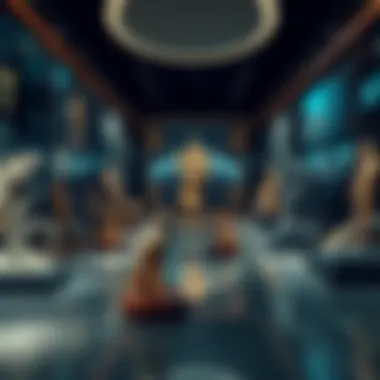
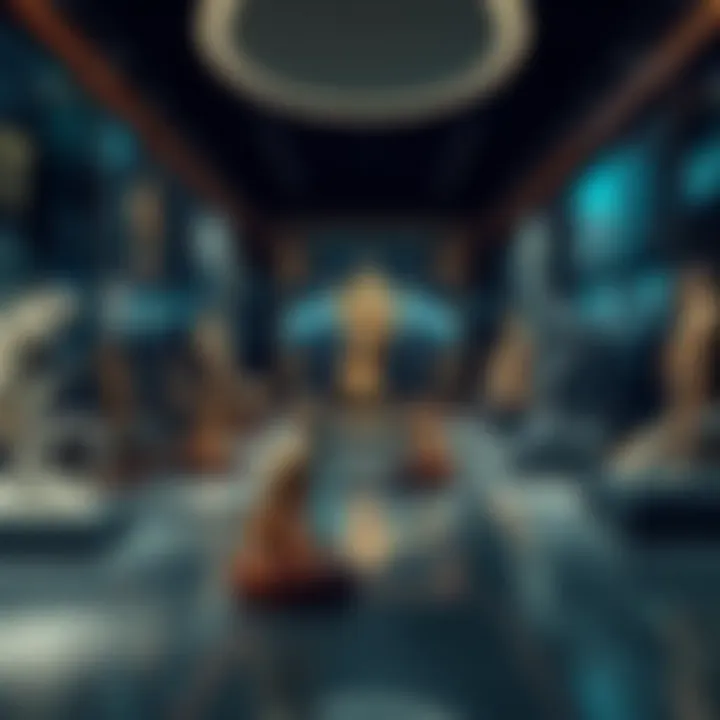
- Market Volatility: The NFT market can swing wildly. Prices may plummet overnight, and assets might lose appeal as quickly as they gained it.
- Legal Grey Areas: Issues surrounding copyright and ownership rights can cloud investment decisions. Understanding the underlying legal framework is crucial but complex.
The intersection of NFT art and investment not only transforms the artistic landscape but forces a reconsideration of long-held economic principles. What does it mean to own a piece of digital art? Questions linger, and so does the allure of quick riches.
Comparative Analysis: Physical vs. Digital Market
The age-old debate between physical art and digital representations has taken on new relevance with the rise of NFTs. Traditionally, physical art pieces come with a tangible connection; you can walk into a gallery, touch the canvas, and feel the brushstrokes. In contrast, digital artworks exist across virtual platforms and rely on blockchain technology for authenticity. Let's break down some key comparisons:
- Authenticity and Ownership: The blockchain offers unparalleled traceability, creating a clearer ownership path than often murky provenance trails in the physical market.
- Storage and Preservation: While physical artworks require maintenance and proper climate control, NFTs eliminate such concerns. However, the reliance on technology raises questions about longevity and accessibility in the long term.
- Market Dynamics: Traditional art auctions remain dominated by a few elite institutions, while digital art platforms are inherently decentralized. This shift can shift market influence from a selective few toward a broader audience of potential investors.
As the lines blur between these two realms, it's clear that both hold their unique charm and challenges. The economic implications of NFT art and sculpture are expanding, requiring artists, investors, and collectors alike to adopt a more nuanced understanding of what it means to invest in an ever-evolving art world.
"In the blink of an eye, the art landscape is changing. Adjusting to these currents is essential not just for survival but for thriving in a digital-first world."
With technology and creativity fused together, intriguing opportunities await those willing to navigate the uncharted waters of NFT art and sculpture.
Cultural Impact and Future Directions
The intersection of NFT art and sculpture is reshaping cultural narratives, steering discussions in new directions. Understanding the cultural impact of this relationship is crucial as it reflects societal values, engages communities, and challenges existing norms around ownership and creation in art. As artists embrace NFTs, they navigate uncharted territory, which enriches the art scene with diverse viewpoints and innovative forms of expression.
Sculpture as a Medium for Social Commentary
Sculpture has traditionally served as a powerful medium for social commentary. Today, NFT sculptures evolve that role further by providing artists with alternative spaces to critique societal issues. For instance, consider an NFT sculpture that tackles climate change; it can depict melting glaciers or endangered species using augmented reality overlays that bring static representations to life. Such works invite viewers not only to consider the aesthetic but also to engage with the pressing challenges we face. This engagement transforms the audience from mere spectators into active participants in the conversation.
Artists can also leverage platforms like OpenSea and Rarible to reach global audiences with their messages. The digitization of sculptural works allows for broader distribution, spurring dialogues across cultural and geographical borders.
"Art must be an integral part of the human experience; with NFTs, artists reimagine what that experience can be for both themselves and their audiences."
Emerging Trends in NFT Art Communities
As NFT art communities flourish, they create a vibrant ecosystem that promotes collaboration and innovation. Artists are forming collectives, sharing ideas, and exploring new mediums within the NFT framework. Social platforms like Discord and Telegram are increasingly becoming essential for these communities, where individuals exchange knowledge about tools, techniques, and market trends.
These communities also pave the way for initiatives that encourage inclusivity and diversity. A notable example is the rise of platforms aimed at underrepresented artists, providing them with resources and exposure that traditional galleries may not offer. This grassroots movement helps democratize the art world, ensuring that voices often sidelined gain visibility.
Moreover, there is a noticeable trend towards integrating gamification in art experiences. Artists are experimenting with interactive sculptures that rely heavily on audience participation. This ongoing evolution captivates audiences, making art more accessible and engaging.
Future Perspectives on Art and Technology
Looking ahead, the landscape of art and technology will undoubtedly intertwine more intricately. The future is ripe for exploration in areas such as virtual reality and augmented reality, which can augment the experience of physical sculptures, creating a hybrid viewing space. Imagine strolling through a gallery where each piece is complemented by an immersive digital installation that further enriches its narrative.
Moreover, advancements in artificial intelligence could lead to new collaborative works where human creativity meets machine learning in unexpected ways. For instance, AI-generated sculptures could challenge our perceptions of authorship and value in art, blurring the boundaries even further.
As these developments unfold, it is essential to consider how they will affect traditional artistic practices and institutions. The conversation regarding copyright, ownership, and valuation in digital art continues to evolve, driven by the emergence of NFT ecosystems. Keeping pace with these changes will be imperative for investors, artists, and collectors alike as they navigate the future of this exciting convergence.
By understanding the cultural dimensions of these trends, stakeholders can better position themselves within the art market, anticipating shifts that could redefine engagement, valuation, and the function of art in a digital society.
Culmination
The relationship between NFT art and sculpture is intricate and deserving of close examination, especially in our increasingly digitized world. This article has trekked through vast landscapes of thought and creativity, revealing just how intertwined these formats have become. As technologies evolve, understanding the nuances of this relationship becomes paramount for artists, collectors, and investors alike.
Summarizing the Relationship between NFT Art and Sculpture
NFTs have fundamentally shifted perceptions of ownership and authenticity in the art world. When it comes to sculpture, this shift is particularly profound. Unlike traditional art forms that demand a physical presence, NFT sculptures offer a new kind of existence, freeing artists from the constraints of tangible materials. Take, for instance, how artists like Mike Winkelmann, known as Beeple, create stunning digital sculptures that exist solely in the virtual realm. Their value is not anchored in their physicality, but rather in the scarcity and provenance marked by blockchain technology.
The synergy between NFT art and sculpture can be summarized through a few key points:
- Digital Accessibility: Artists from diverse backgrounds can now showcase their work to a global audience, breaking down barriers.
- Innovative Aesthetics: The potential for interactivity and viewer participation elevates these works beyond aesthetic pleasure, engaging audiences on multiple levels.
- Market Dynamics: The emerging NFT marketplace is reshaping how we evaluate and invest in art, presenting risks but also lucrative opportunities.
This evolving connection signifies not just an evolution of art forms, but a cultural shift that challenges our understanding of value in the art space.
Reflections on the Evolving Nature of Art
Art has always been reflective of its time, and as our world becomes more digital, it is only natural that art bends and reshapes accordingly. The advent of NFTs has spurred conversations that question the very essence of what it means to create and own art.
- Cultural Commentary: Artists are increasingly using their work to comment on contemporary issues. The permanence of blockchain allows for these messages to be locked in time, reminiscent of social sculptures in “real life.”
- Next-gen Creatives: Today’s artists are more tech-savvy and open to experimentation. They aren’t just sculpting; they’re programming experiences that captivate audiences.
- Future Speculations: It's essential to consider where this goes. Will physical sculptures become obsolete, or will they exist harmoniously alongside their digital counterparts?
The fusion of NFT art and sculpture serves as a harbinger of a new age in the art world, one that acknowledges the ephemeral, embraces the digital, and most importantly, celebrates the human experience in an ever-evolving landscape. As we look forward, continuing to understand these dynamics will be crucial, whether you're an investor, a collector, or an artist on the rise.
"In the end, the most valuable art is not just what is seen, but what is felt across the layers of reality."
For further insights on the intersection of art and technology, consider exploring resources from Wikipedia, Britannica, or discussing on platforms like Reddit for community perspectives.







